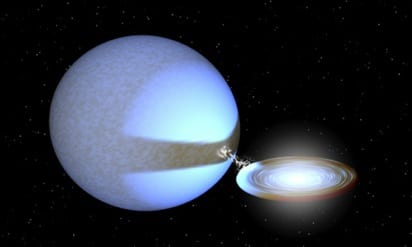Astronomers have found a black hole that is consuming gas from a nearby star 10 times faster than previously thought.
The black hole, known as P13, is situated near the galaxy NGC7793, about 12 million light years from earth and is ingesting a weight equivalent to 100 billion billion hot dogs every minute.
The discovery was published today in the journal Nature.
Dr Roberto Soria from the Department of Imaging and Applied Physics and Research Astronomer with the International Centre for Radio Astronomy Research said that as gas fell towards a black hole it become very hot and bright.
“Scientists first noticed P13 because it was a lot more luminous than other black holes, but it was initially assumed that it was simply bigger,” Dr Soria said.
“It was generally believed the maximum speed at which a black hole could swallow gas and produce light was tightly determined by its size.
“So it made sense to assume that P13 was bigger than the ordinary, less bright black holes we see in our own galaxy, the Milky Way.”
When Dr Soria and he his colleagues from the University of Strasbourg measured the mass of P13 they found it was actually on the small side, despite being at least a million times brighter than the sun. It was only then that they realised just how much material it was consuming.
“There is not really a strict limit as we thought, black holes usually consume more gas and produce more light.
“P13 rotates around a supergiant ‘donor’ star 20 times heavier than our own Sun.”
Dr Soria said the scientists saw that one side of the donor star was always brighter than the other because it was illuminated by X-rays coming from near the black hole, so the star appeared brighter or fainter as it went around P13.
“This allowed us to measure the time it takes for the black hole and the donor star to rotate around each other, which is 64 days, and to mode the velocity of the two objects and the shape of the orbit.
“From this, we worked out that the black hole must be less than 15 times the mass of our Sun.”
Dr Soria compared P13 to small Japanese eating champion Takeru Kobayashi.
“As hotdog-eating legend Takeru Kobayashi famously showed us, size does not always matter in the world of competitive eating and even small black holes can sometimes eat gas at an exceptional rate.”
Dr Soria said P13 is a member of a selected group of black holes known as ultra-luminous X-ray sources.
“These are the champions of competitive gas eating in the Universe, capable of swallowing their donar star in less than a million years, which is a very short time on the cosmic scales.”
ICRAR is a joint venture between Curtin University and The University of Western Australia with support and funding from the State Government of Western Australia.
The study was led by Dr Christian Motch from the University of Strasbourg.
Original publication details:
‘A mass of less than 15 solar masses for the black hole in an ultra-luminous X-ray source’ was published in Nature on 09 October 2014. C. Motch, M. W. Pakull, R. Soria, F. Gris´e, G. Pietrzy´nski.
Images:
The below images are available on the ICRAR website.





